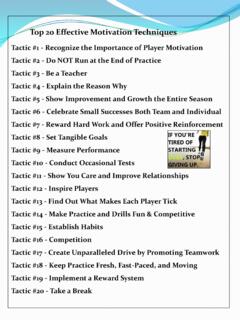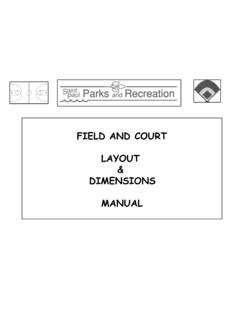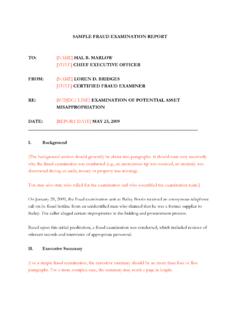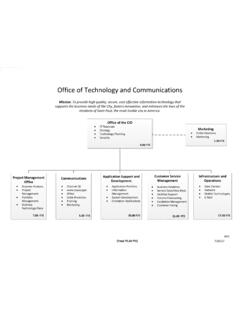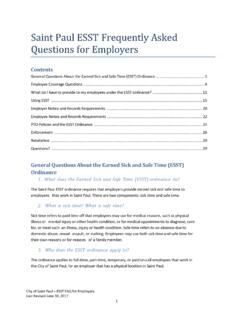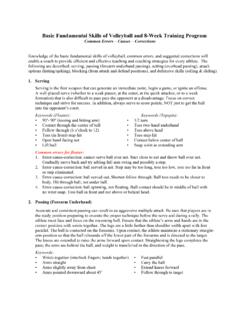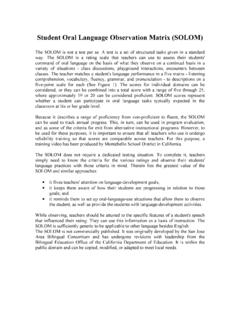Transcription of Passing and Catching are a very important part of a ...
1 Passing and Catching are a very important part of a Basketball game! A successful team makes strong and accurate passes, and always catches the ball. Coaches must ensure that their players understand the fundamentals and mechanics of Passing and Catching and then drill them into them during practices. How to teach and coach basketball players to pass and catch a basketball Catching the Ball A pass is only good if it can be caught. Therefore, your players should always be ready to catch the ball. They need to anticipate both when and where the pass will be thrown. In order to catch the ball they should: Get as open as possible and present a good target to the passer. To receive the ball: Keep hands out from the chest. Keep fingers pointed up and spread comfortably, with the thumbs almost touching each other. This position enables them to immediately get a good hold on the ball.
2 Between the passer and the receiver there is an unspoken signal to pass the ball: the raised and open hands of the receiver. This tells the passer, "I'm open! Give me the ball! Not every pass will be perfect. They must be ready to move from side to side for a poorly thrown or deflected pass. Keep eyes on the ball from the time it leaves the passer's hands until they actually touch the ball. Taking eyes off the ball for only a split-second can cause a fumbled pass. Step toward the ball as it comes with arms out to decrease the length of the pass. Also, this prevents the defense from stepping in front and stealing the ball. After the ball hits their fingers, bend elbows slightly and bring the ball in toward their chest. This cushions the impact of the pass and gives better control of the ball. Now, that they have the ball at chest level, they are in a position to pass or shoot quickly.
3 A) The receiver must be ready to catch the ball by showing a target (have their hands up and ready to receive the ball at all times). b) Players should not let the ball hit their body, they must always catch the ball with their hands. c) Players must look the ball into their hands each and every time they catch the ball. The younger players tend to turn their heads when they are about to receive the pass. d) When Catching the ball a player must firmly grab and hold the ball be strong when holding the basketball. e) Players should step towards the ball to catch it (never step backwards). Meet the pass, come to the pass, step to the pass! Passing Sets Up Winning Shots Passing is the quickest and most effective way to get the ball from player to player and move it around the court. The more passes that are made by the offense, the more you will challenge the defense.
4 It keeps them scrambling, frustrated, and tired. The perfect end result of a series of well-executed passes will be to an open man close to the basket. He can take the ball and easily score. The Five Passing Lanes Each game situation presents the possibility for one perfect pass. Imagine yourself faced by a defender crouched over in good defensive position. What you should now see is not just this player, but actually, five possible Passing lanes. These five lanes are: the top of the defender's head. the left side of his head. the right side of his head. his right leg. his left leg. If you are well guarded by your man you won't be able to pass the ball immediately where you want to. In cases like this, fake with the ball. Fake with your body; or, fake with your body and the ball. Once the defender goes for the fake, pass through one of the five lanes.
5 Principles of Passing the Basketball: Passing the basketball is an offensive skill that requires lots of practice. Ensure that the players practice proper Passing techniques / mechanics at all times. a) Players should try to make the shortest pass, usually a coach will refer to this as make the easiest pass. The longer passes are not as accurate and tend to get stolen by the defense. b) Players should pass the ball to the receivers hands (the target). c) Teach your players to pass with their thumbs starting behind the ball and ending with their thumbs pointing downwards. d) Players should always make strong passes, soft passes will get stolen or deflected by the defense. e) When Passing the ball, the pass should be thrown to the opposite side of the receivers defender (don t make it easy for the defender to steal the pass).
6 Passing Mechanics: Teach your players to pass with their thumbs starting behind the ball and ending with their thumbs pointing downwards see pictures below. This is a very basic, but important skill to learn, coaches need to just drill it into your players until they are comfortable with it. Notice how the thumbs are pointing downward after the ball is passed. Player has a firm grip on the ball and is ready to pass the Player steps towards the teammate they are Passing Thumbs are downward after the ball is The Two-Handed Chest Pass The chest pass is the most common pass they will throw in a game when there isn't a defensive player between them and a teammate. To execute this pass, start with the ball held in two hands chest- high and close to the body. Elbows should be tucked in and fingers spread around the ball with thumbs up.
7 Don't spread your fingers out too far because this positioning will prevent you from making a quick pass. As they hold the ball, wrists should be pointed upward. Holding them downward will force them, first, to turn them up before the pass. This is an unnecessary extra movement that only delays the pass. When they are about to make the pass, step in the direction of their pass. Moving like this gives body balance and gives the pass more power and speed. Don't overextend the step, because this tends to take away some balance. As their arms stretch out to their full length, rotate elbows and wrists outward so that the hands end up in a thumbs- downward, palms-out position. Release the ball with a snap of your wrist. Spin the ball with the index fingers, middle fingers, and thumbs as it leaves the hands. This spin on the ball causes it to travel in a straighter line.
8 This type of pass is easier to catch than a "flat spinless pass. The Two-Handed Bounce Pass The basic mechanics of the bounce pass are the same as those of the chest pass; however, the game situation for each of the passes are different. A bounce pass is a good one to use on a back- door play. It is also the pass to use when Passing to a teammate, guarded from behind in the low post, or in other situations when a defender is between the passer and the receiver. Starting with the same position as the two-handed chest pass, take a strong step in the direction of the receiver. Quickly extend the arms and palms outward. Backspin is put on the ball as it go from thumbs up to a thumbs down release position. This backspin makes the ball easier to catch. The ball must hit the floor at least three-quarters of the distance to your receiver.
9 It should come up to him/her at the thighs and waist. The Two-Handed Overhead Pass The overhead pass is commonly used for moving the ball around the perimeter, as a skip pass, a pass into the post area, and as an outlet pass. When they make this pass, always aim the ball a little over the head of the receiver. To make an overhead pass, hold the ball over the head and slightly back of the center of the head. Don't hold the ball BEHIND the head. This wastes movement and time. Fingers should be spread firmly around the ball, thumbs a couple of inches apart at the bottom of the ball. This pass gets its power from the flick of the wrists and fingers. As the passer steps toward the receiver, snap the wrists and rotate both arms and palms outward. Hands should end with the fingers pointing upward. The Lateral Pass The starting position is the same as the two-handed chest pass.
10 With the defender standing in front of the passer, the passer steps across his/her body with the foot opposite the ball. This protects the ball. Bring the ball to their side and extend arms. Quickly cock the outside wrist, drop the helper hand, and snap the ball to the receiver. A variation of this pass is the lateral bounce pass made with one or both hands. If this pass is used, the ball must be bounced to a spot, at least, three-quarters of the distance to the receiver. The Behind-The-Back Pass This pass used to be considered a "show-off" pass; however, it now has become a normal offensive weapon. Still, it MUST NOT be abused. To make the pass, hold the ball with two hands. As the ball is brought back around the hip, the helping hand drops off. The Passing hand is on the side of the ball and must thrust the ball behind the back.
